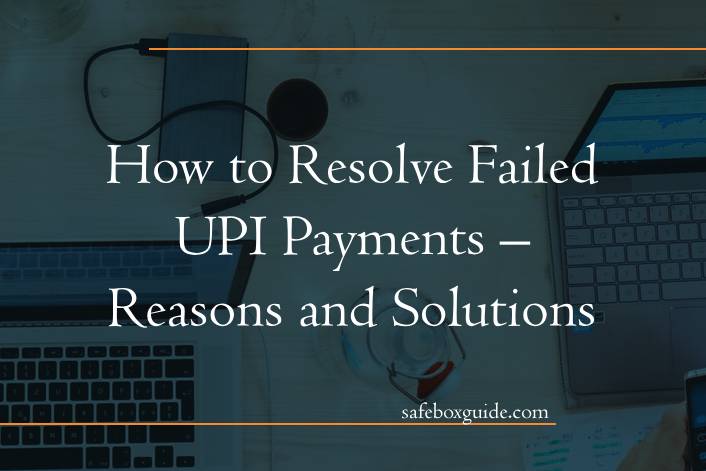Unified Payments Interface (UPI) has revolutionized the way we make digital payments in India. It allows users to instantly transfer money, pay for goods and services, and handle other transactions with ease. However, despite its convenience, UPI payments occasionally fail due to various reasons. If you’ve ever encountered a failed UPI payment, it can be frustrating, especially in urgent situations. Understanding why these failures occur and how to resolve them can help you avoid future issues.
In this guide, we will explore the common reasons behind failed UPI payments and provide practical solutions to fix them.

Contents
Common Reasons for Failed UPI Payments
1. Insufficient Balance
One of the most common reasons for UPI transaction failure is having an insufficient balance in your bank account. Since UPI directly debits your linked account, you need to ensure that there are enough funds available for the transaction to go through successfully.
Solution:
Before initiating any UPI payment, check your account balance via the UPI app or your bank’s mobile banking application. If you have insufficient funds, top up your account and then retry the transaction.
2. Poor Internet Connection
UPI payments rely on a stable internet connection for real-time processing. If your connection is weak or intermittent, the transaction may fail to go through.
Solution:
Ensure that you have a strong and stable internet connection before initiating a UPI payment. If you experience connectivity issues, switch to a stronger network or move to an area with better signal strength. Alternatively, you can wait until your internet connection stabilizes.
3. Bank Server Downtime
Sometimes UPI payments fail due to your bank’s servers being down for maintenance or experiencing high traffic. When this happens, you won’t be able to complete any transactions until the servers are back online.
Solution:
If the failure is due to server downtime, try waiting for a few minutes and then attempt the transaction again. You can also check your UPI app for any bank outage notifications or use a different bank account linked to UPI if the issue persists.
4. Exceeded UPI Transaction Limits
UPI transactions come with daily limits, both in terms of the number of transactions and the total amount you can transfer in a day. If you exceed these limits, your transactions will fail.
Solution:
Be mindful of the daily transaction limit set by your bank and UPI. If you’ve hit the limit, you’ll need to wait for the next day to resume UPI transactions. Alternatively, try using another UPI account or payment method if the transaction is urgent.
5. Wrong UPI PIN
Entering an incorrect UPI PIN can cause a transaction to fail. Each UPI transaction requires you to authenticate using a PIN that you set when linking your bank account.
Solution:
If your UPI payment fails due to an incorrect PIN, make sure to carefully enter the correct PIN the next time. If you’ve forgotten your PIN, use the UPI app to reset it through the “Forgot UPI PIN” option.
6. Inactive Bank Account
If the bank account linked to your UPI app is inactive, payments will fail. This can happen if your account has been dormant for an extended period, or if it has been closed without your knowledge.
Solution:
Ensure that the bank account linked to UPI is active. You can visit your bank or contact customer support to confirm the status of your account. If it is inactive, you may need to re-activate it or link a different active account to your UPI app.

7. Incorrect VPA (Virtual Payment Address)
Another common reason for failed UPI payments is entering the wrong Virtual Payment Address (VPA) or UPI ID. If the recipient’s UPI ID is incorrect, the payment will not go through.
Solution:
Always double-check the recipient’s UPI ID before confirming the payment. A small error in typing can lead to failed transactions, so it’s important to be meticulous when entering the VPA.
Solutions to Fix Failed UPI Payments
1. Retry the Transaction
In some cases, a payment may fail due to temporary issues like server overload or poor connectivity. Simply retrying the transaction after a few minutes can often resolve the issue.
2. Contact Bank or UPI App Support
If the payment continues to fail and the reason is unclear, it’s best to reach out to your bank’s customer support or the UPI app’s support team. They can provide insights into why the payment failed and guide you through the resolution process.
3. Check Payment Status
Sometimes, even if the app shows that a payment failed, the money may still be deducted from your account. You can check the status of the transaction within your UPI app or bank statement. If the money has been deducted, but the transaction wasn’t completed, most UPI systems will automatically refund the amount within 2-3 business days.
4. Use an Alternative Payment Method
If UPI continues to fail due to persistent issues, consider using an alternative payment method like NEFT, IMPS, or net banking to complete your transaction.
Failed UPI payments can be caused by a variety of factors, ranging from insufficient funds and poor internet connectivity to incorrect PIN entries and bank server downtimes. By understanding the reasons behind these failures and following the solutions provided, you can resolve most UPI issues quickly and efficiently. Always ensure you have a stable internet connection, enter the correct details, and keep track of your bank account and UPI limits to avoid transaction failures.

